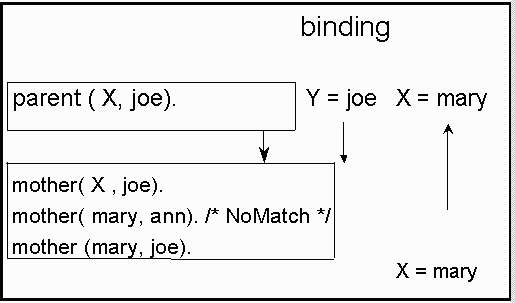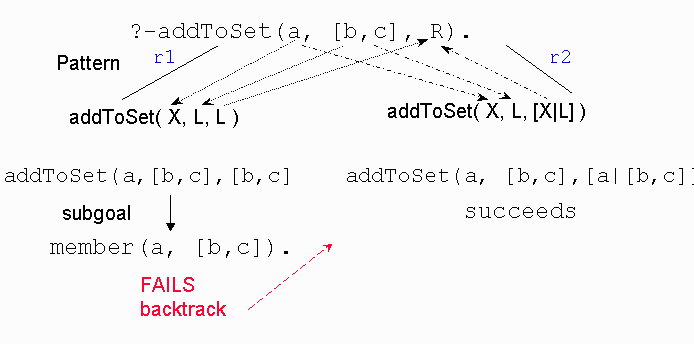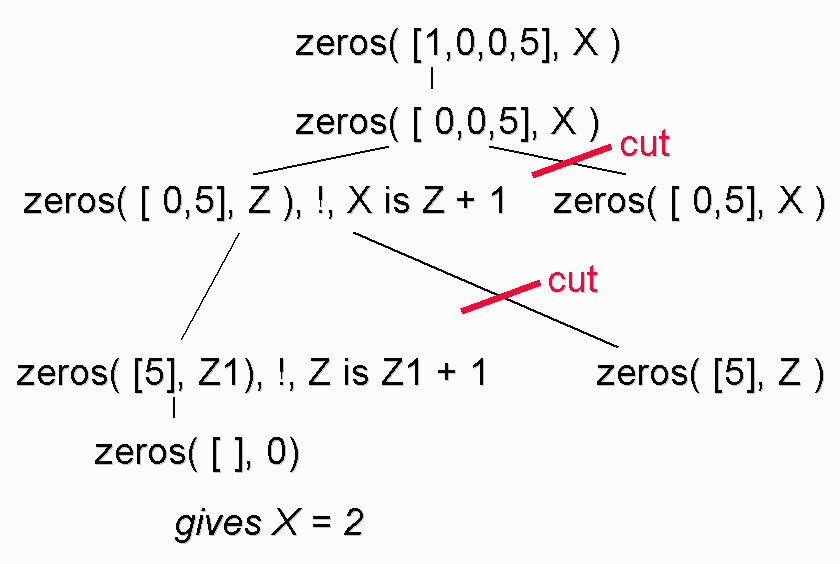Programming in Prolog
What will be covered?
-
�Some
logical operators
�
-
Review
of
binding of values
�
-
Review
of
how prolog executes a query
�
-
-
Programming
"what" not "how"
�
-
-
-
A logic
programming
language is
a
notational
system for writing logical statements
together
with specified algorithms for implementing inference rules.
family.pl program
/*
If
mother(
X ,Y ) then parent( X ,Y ) */
parent(
X
, Y ) :- mother( X , Y ).
parent(
X
, Y ) :- father( X , Y ).
/*
if
parent(
X ,Y ) and parent(Y,Z ) then grandparent( X ,Z ). */
grandparent(
X
, Z ) :- parent( X , Y ),parent(Y, Z ).
- the following fact is redundant
-
Logical Operators
- �true : goal always succeeds
- fail : goal always fails
- = (equality)
: A term X = Y
succeeds if X and Y match
- Prolog will try to match them
- \= (inequality)
: \= is the opposite of
=
- X ; Y : Disjunction
(or)
of two goals
- parent( X , Y ) :- mother( X
, Y ); father( X , Y ).
parent(
X
, Y ) :- mother( X , Y ).
parent(
X
, Y ) :- father( X , Y ).
Execution model : Unification, pattern matching and backtracking
/* facts */
mother(mary, ann).
mother(mary, joe).
mother(sue, mary ).
father(mike, ann).
father(mike, joe).
/* rules */
parent( X , Y ) :- mother( X , Y ).
parent( X , Y ) :- father( X , Y ).
/* Query */
?- parent( X , joe).
X = mary
true .
- curious.pl
- What is the result of
?- jealous(A,B).
Why?
- What is the sequence of binding the variables to a value? What
is the sequence of execution?

Review of Recursion -- Divide and Conquer
-
general
cases where the solution is constructed from solutions of (simpler)
version of the original problem itself.
-
trivial,
or boundary case
Example - What is the length of a list?
- What is the general formula?
- What is the boundary condition?
Converting to Prolog
- Relations NOT functions
- NO return values!
- Where does the "length" value stored?
- length( [ ], 0 ).
length([H
|
T], Acc) :-
-
length(T,Nx),
-
Acc is Nx + 1 .
(note: length is build in and this code will
cause an error.)
Executing length--
?- length ([ 1, 59, 49], X).
?- length ( jim, X).
?- length ( Jim, X).
What will happen if we change the order of the rules?
- length2([H | T], Acc) :-
-
Acc
is Nx + 1, length2(T,Nx).
- length2( [ ], 0 ).
Another example -- writing code to implement set operations
- Using lists as the container for implementing bags and sets.
- Problem: Is Elem a member of a Set?
- Base case:
Recursive (general rule):
- Consider what happens if Elem is not in the set. What should
happen?
- Member relation
A break in the logical Model : write -- is extra logical to provide I/O
?-
X = [1, 2, 3], write( X ), nl, mymember(a, X ).
[1,
2, 3] ;
false.
?- mymember(a, X ),
write( X ), nl, X
= [1, 2, 3].
[a|
_3] ;
[
_5, a| _7] ;
[
_5, _8, a| _9] ;
[
_5, _8, _11, a| _12] ;
[_5,
_8, _11, _14, a| _15] ;
intersect( SetA, SetB, Intersection)
- What is the base case?
- Need to select which set to recurse on.
- What are the two recursive (general) rules?
- ?? "head" in both sets match
- ?? otherwise
- Intersect relation
union( SetA, SetB Union)
addToSet( E, SetA, Result )
- �If
E
is in the SetA what should Result be?
- How do
you check that E is in SetA?
- If
E
is NOT a member of SetA what should Result be?
- No
recursion
just
use the pattern matching power of Prolog and
backtracking!
r1: addToSet(
X,L,L ) :- member( X, L ).
r2: addToSet(
X,L,[X|L]
).

Declarative Meaning vs
Procedural Meaning
- Declarative
meaning
is concerned only with relations
by
the program.
- Declarative meaning determines what will be
the output of the program.
What does GCD mean? What are the axioms that define GCD?
- GCD of any number, n,
and zero is n
- GCD of m,
n is equal to the GCD of n,
m
- GCD of m
& n is the
GCD of mod (m , n
) and n if m
> n
Converting to Prolog.
gcd(
A, 0, A ).
gcd( A, B, D ) :- (A<B), gcd( B, A, D ).
gcd( A, B, D ) :- (A>B), (B>0),
R
is A mod B, gcd( B, R, D ).
- Remember is breaks the
logical model.
-
�Notice
that
"is"
operator evaluates the expression first then the result
to unification with R.
Converting specification of n!
to Prolog.
Recursive
definition:
n! = n
*
( n - 1)!
0!
= 1
factorial(N, M):- N1 is N -
1,
factorial
(N1, M1),
M is N*M1.
How does it work?? What is the binding?
Fibonacci Sequence
- Recursive definition:
- Code:
-
fibonacci_1( X , 1) :- X
=< 2.
fibonacci_1( X , Y ) :- X >
2,
X1 is X - 1,
X2 is X -
2,
fibonacci_1(
X 1, Y1),
fibonacci_1(
X 2, Y2),
Y is Y1 + Y2.
Improvements for calculation speed.
fibonacci_2( 1, 1).
fibonacci_2( 2, 1).
fibonacci_2( X, Y ) :-
X > 2, X1 is X - 1,
X2 is X - 2,
fibonacci_2(
X1, Y1 ),
fibonacci_2(
X2, Y2 ),
Y is Y1 + Y2,
asserta(fibonacci_2( X,Y ))).
- Variation of Dynamic Programming
- Using state varables to pass values from one iteration to the next.
- How can you simulate an array?
-
fibonacci_3( N, Fib):-
fib_aux( 2, N, 1, 1, Fib ).
fib_aux ( N, N, F1, Fib, Fib ).
fib_aux ( M, N, F1, F2,
F ) :- M
< N,
NextM
is M + 1,
NextF2
is F1 + F2,
fib_aux(NextM, N,
F2, NextF2, F).
Cuts - used to control backtracking (procedural)
p( X ) :- q(X).
p( X) :- r( X, Y ),
! , s( Y ).
p( X ) :- t( X).
?- p(fred).
clause 2
will be reach only if q(fred)
fails. If it reaches the cut symbol then it found the first
solution to r(fred,Y).
With the cut it will only solve s(Y) for the current
instantiation of Y. If s(Y) fails it will
not try alternatives for r(fred,Y). It will
NOT even try the third clause! Alternatives
deviations that were created before the selection of the p(fred)
literal are not discarded by the cut, the same for
alternatives created after the cut.
Red cuts and green cuts
f(N,0) :- N <
3.
%rule 1
f(N,2) :- 3=< N, N <
6.
%rule 2
f(N,4) :- 6 =< N.
%rule 3
f(N,0)
:- N < 3, !.
%rule 1
f(N,2) :- 3=< N, N <
6,!.
%rule 2
f(N,4) :- 6 =< N.
%rule 3
f(N,0)
:- N < 3, !.
%rule 1
f(N,2) :- N < 6, !.
%rule 2
f(N,4) .
%rule 3
More on cuts
max(X, Y,
Z) is true if Z is the maximum of X & Y
max(X,Y,X)
:-
X >= Y.
max(X,Y,Y) :- X < Y.
Green cuts,
discards no solutions at all or discards only solutions of no
interest.
maxGreen(X,Y,X) :- X >= Y, !.
maxGreen(X,Y,Y) :- X < Y.
Red cuts,
sometimes make it
difficult to understand programs
but worse
it may be incorrect in terms of the problem to be solved.
maxRed(X,Y,X)
:-
X >= Y, !.
maxRed(X,Y,Y).
Diagram of the effect of using cuts.
fragileZeros( [ ], 0).
fragileZeros([ 0 | T ], Z) :- fragileZeros(T,
Z1), Z is Z1 + 1.
fragileZeros( [ _ |T ], Z ) :- fragileZeros(
T, Z ).
zeros( [ 0 | T ], Z ) :� zeros(
T, Z1), !, Z is Z1 + 1.
zeros( [ _ | T ], Z ) :� zeros(
T, Z ).

Another example of cuts... Beware of the order of subgoals!
haveCommonElts1(
X
,Y ) :- mymember( E, X ),
mymember( E, Y ).
haveCommonElts2(
X
,Y ):- mymember( E, X ),
mymember( E,Y ), !.
? �
haveCommonElts1( X , [1, 2, 3] ).
X
= [1| _14];
X
= [2| _14];
X
= [3| _14];
X
= [ _16, 1| _18];
X
= [ _16, 2| _18];
X
= [ _16, 3| _18];
? -
haveCommonElts1( [1, 2, 3], Y ).
Y
= [1| _33];
Y
= [_35, 1 | _36];
Y
= [_35, _39, 1 | _40]
...
Graphs in Prolog
- What is a graph?
- How can we represent a graph on black in Prolog?
Not!! Another break of the Logical Model
not(P) :- call(P), !, fail.
alternatively:
not(P):�
P,
!, fail; true.
alternatively:
not(P):�
P,
!, fail.
not(P):-true.
test(
S, T) :- S = T.
1?- test( 3, 5).
no
2?- test( 5, 5).
yes
3?- not( test( 5,5)).
no
4?- test( X,3), R is X+2.
X=3
R=5
5?- not( not( test( X,3))), R is X+2.
warning unbounded variable in
arithmetic expression fail ...
/* When
not(test(X,3)) fails the instantiation of X to 3 is released */
/* X instantiated to
0, then not( 0= 1) succeeds. */
6?- X = 0, not( X=1).
/* X
instantiated to 1, not( X=1) fails, the
goal X = 0 is never reached */
8?-
not(
X=1 ), X=0.
9. ?- A=B,
not(not(A=3)),B=5.
What do you think happens?
10?-
A=3,not(not(A=3)), A=B, B=5
What
do you think happens?
-------------------------
Findall
findall(+Template, :Goal,
-Bag)
[ISO]
Create a list of the instantiations
Template gets successively on
backtracking over Goal and unify the
result with Bag. Succeeds
with an empty list if
Goal has no solutions
Examples of uses:
?- findall(C, member(C,[1,2,3]), B).
?-
findall(C, (member(C,[1,2,3,-4]),C>1), B).
B = [2, 3].
?-
findall(I, (member(C,[10,2,13,5]), I is C+15, I>20), B).
B = [25, 28].
----------------------------------------
Other Extra-Logical Operators
- is, =:=
- write(X)
- write_canonical(L)
- var , nonvar
- var(X)
tests whether x is unbound
(free)
Homoiconicity
is a property of some
languages, in which the primary representation of programs is also a data
structure of the language itself. This makes metaprogramming
easier than in a language without this property.
?-
D
= (Exp is 44 // 7 ), call(D).
?-
E = (Exp is 44 / 7), E.
?-
L = (ten(X):-(X is 2*5)), write_canonical(L), assert(L), ten(A).
%% *1
?-
listing(ten).
?-
retract( (ten(X):-(X is 2*5)) ).
?- C = (newrule(E):-E
is 44 // 7),
assert(C).
?- newrule(X).
?- A=newrule, A(X).
#BAD
?-A
=.. [newrule, X], A.
?- call(newrule, X).
*1) :- dynamic
ten/1. # must be at the top of the program file (OR put ten(A)
in another query).
call/2
Append ExtraArg1, ExtraArg2, ... to the argument list of Goal and call
the result. For example, call(plus(1), 2, X) will call plus(1, 2, X),
binding X to 3.
?Term =.. ?List
List is a list
whose head is the functor of Term and the remaining arguments are the
arguments of the term. Either side of the predicate may be a variable,
but not both. This predicate is called `Univ'.
Code related to these notes:
example.pl
intersect.pl
find.pl
sendMoreMoney.pl



